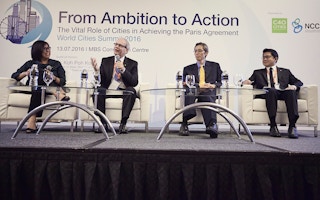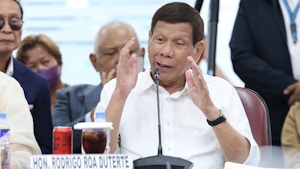The Paris climate change accord is one of several global agreements forged among nations in 2015 to 2016 that will have implications for city leaders for years to come. But what exactly is the Paris Agreement, and how does it relate to the quest for building more sustainable cities?
Here’s an overview of the major questions and issues.
What is the Paris Agreement?
The Paris Agreement on climate change is a voluntary accord among 197 countries to reduce their greenhouse-gas emissions. Specifically, the Paris Agreement aims to keep the world’s mean temperature from rising by more than 2ºC above pre-industrial levels by the year 2100 — and ideally, contain rising temperatures to 1.5ºC.
Scientists believe that keeping planetary warming below this level is necessary to avert the worst effects of global climate change, such as a rising sea level and more frequent extreme-weather events. (See the text of the Paris Agreement here.)
Diplomats brokered the deal in December 2015 at the Paris Climate Conference, known in United Nations parlance as COP 21. To achieve the agreement’s long-term goals, countries prepared emissions-reduction plans that negotiators brought with them to Paris.
Those plans go into effect in 2020. Every five years, nations are expected to “ratchet up” their plans with more ambitious pledges. That’s because the plans presented in 2015 were not sufficient to hit the 2ºC target.
The UN Environmental Programme has estimated that if countries make do on their 2015 pledges — and it’s not clear that they will — it would still lead to a global mean temperature rise of 2.9°C to 3.4 °C.
When did the agreement take effect?
Once the agreement was reached, UN Secretary-General Ban Ki-moon went on a major diplomatic charm offensive to convince countries to ratify it. Under the terms of the agreement, 55 countries representing 55 per cent of global emissions had to approve the deal in their national legislatures.
At least one of the “big four” emitters — China, the European Union, Russia and the United States — had to sign on.
A special ceremony was held on Earth Day 2016 for countries to submit their so-called “instruments of ratification”.
Less than six months later, the UN reached the magic number, making this ratification process one of the fastest in diplomatic history. The Paris Agreement formally “entered into force” on 4 November 2016. By that time, 73 countries had joined the agreement, including the US, China and the European Union.
Today, just three countries have not signed it: Russia, Iran and Turkey.
Why are cities important to the Paris Agreement?
In many ways, cities are both the problem and the solution when it comes to greenhouse-gas emissions. And they have a lot to lose from flooding, drought and disease if climate change spirals out of control.
Cities are responsible for the bulk of the world’s carbon dioxide emissions. Private automobiles on city streets are a big culprit. So are buildings, and the energy consumed by lighting, heating and cooling them.
According to the C40 Cities Climate Leadership Group, cities consume over two-thirds of the world’s energy and account for more than 70 percent of global carbon dioxide emissions.
At the same time, some of the most promising low-carbon innovations are happening in cities. From efforts aimed at boosting walking, biking and transit to promoting energy efficiency, many mayors have been aggressive about finding ways to squeeze carbon out of their cities.
What role did cities play in bringing the deal together?
None directly — the diplomats hashing out the details were all representatives of national governments. Cities had no formal “seat at the table” during the feverish two weeks of negotiations in Paris.
Indirectly, however, cities had a major impact. Mayors showed up in force in Paris, and were among the loudest voices in a global outcry demanding action.
What made the Paris deal successful — after two decades of failed efforts to reach an agreement — was intense global pressure from every corner of the world. From indigenous communities to multinational corporations, some 10,000 players from 180 countries also made pledges to reduce their carbon emissions.
They did so in an effort to show national governments that there is a global consensus on the need to halt climate change once and for all.
Mayors argued that cities are well positioned to act immediately — well before national commitments take effect in 2020. According to a U. N. database, cities have made more than 2,500 commitments to slash their greenhouse-gas emissions. That’s more than the number of commitments from the private sector.
So now that we have an agreement, what are cities actually doing?
Cities around the world are taking steps to promote renewable energy, support electric vehicles, change streetlights to energy-saving LEDs, increase transit use, slash emissions from buildings and a host of other measures.
Just within the more than 80 megacities that make up the C40 cities, members have taken more than 10,000 climate actions, the organisation reported in 2015.
In 2016, the organisation’s Deadline 2020 report indicated that cities alone can reduce 5 per cent of global emissions to meet the Paris Agreement, and in concert with other tiers of government and the private sector, they can potentially reduce 46 per cent.
Generally, there are three steps involved on the road to making measurable progress at the local level. First, to create an inventory of the jurisdiction’s emissions. Second, to set a reduction target. Third, to make a plan to get there.
More than 7,000 cities have publicly pledged to reduce their greenhouse-gas emissions in the wake of the Paris Agreement. Their commitments are consolidated through a platform called the Global Covenant of Mayors for Climate and Energy.
As of March 2017, 7,436 cities around the world, representing 678 million people — nearly 10 per cent of the world’s population — were part of the Global Covenant.
How do city commitments fit into national commitments?
According to a study by UN-Habitat, 110 of the 163 national climate plans presented in Paris “show clear urban references and content”.
The study reported that the role of cities in fighting climate change was highest priority in emerging economies and somewhat neglected in the plans by high-income countries.
Most references to cities relate to how places will plan ahead to avoid suffering the worst impacts of climate change, rather than citing the role of cities in reducing emissions.
That emphasis on “adaptation” over “mitigation” may be a gross oversight. A C40 Cities report issued in late 2016 argued that the world’s megacities must see their emissions peak and begin declining by 2020, otherwise the planet will miss the 1.5ºC mark.
What are the next steps?
The Paris conference was called COP 21 because it was the 21st in an annual series of climate talks. Those will continue — COP 22 took place in Marrakech and COP 23 will take place in Bonn in November.
Meanwhile, the Paris Agreement set out a timeline of what future COPs are to accomplish. At COPs in 2020, 2025 and 2030, countries will present their new climate pledges. In 2023 and 2028, they will also engage in “stocktakes”, or reviews of how progress on the agreement is coming along.
The details of what, exactly, countries will take stock of was not defined in the agreement itself and is subject to ongoing follow-up negotiations.
Meanwhile, cities continue to meet at annual gatherings of mayors who tout their climate leadership. But they will also have a formal role within the U.N climate system for the first time.
The Intergovernmental Panel on Climate Change, the scientific body that advises national governments on the issue, agreed to incorporate a specific urban lens into its research and reports after a successful lobbying campaign called #CitiesIPCC.
In 2018, scientists will convene for the first #CitiesIPCC conference to prepare a research agenda for the panel.
What are the biggest outstanding issues?
Money is a big one — or rather a lack of money. Buying municipal electric vehicle fleets, building “green infrastructure” and opening new mass transit lines as an alternative to private automobiles all costs money. C40 estimates that cities will have to invest USD 375 billion to hit the target of peaking their emissions by 2020.
They might have gotten some of fiscal help from the Green Climate Fund, a financial instrument set up in 2010 that many countries pledged to fund during the Paris talks.
But US President Donald Trump’s proposed budget would zero out contributions to the fund, and other countries may follow. Moreover, existing Green Climate Fund projects don’t have much of an urban focus.
Trump’s election raises other questions. Trump campaigned on a promise to pull the US out of the Paris Agreement — something the US cannot technically do for four years. Whether Trump tries to scuttle the deal or not, he has taken steps to reverse the climate-change policies of former President Barack Obama.
That makes it less likely that the US will meet its Paris pledges, and could encourage other countries to backtrack as well.
This story was published with permission from Citiscope, a nonprofit news outlet that covers innovations in cities around the world. More at Citiscope. org.














